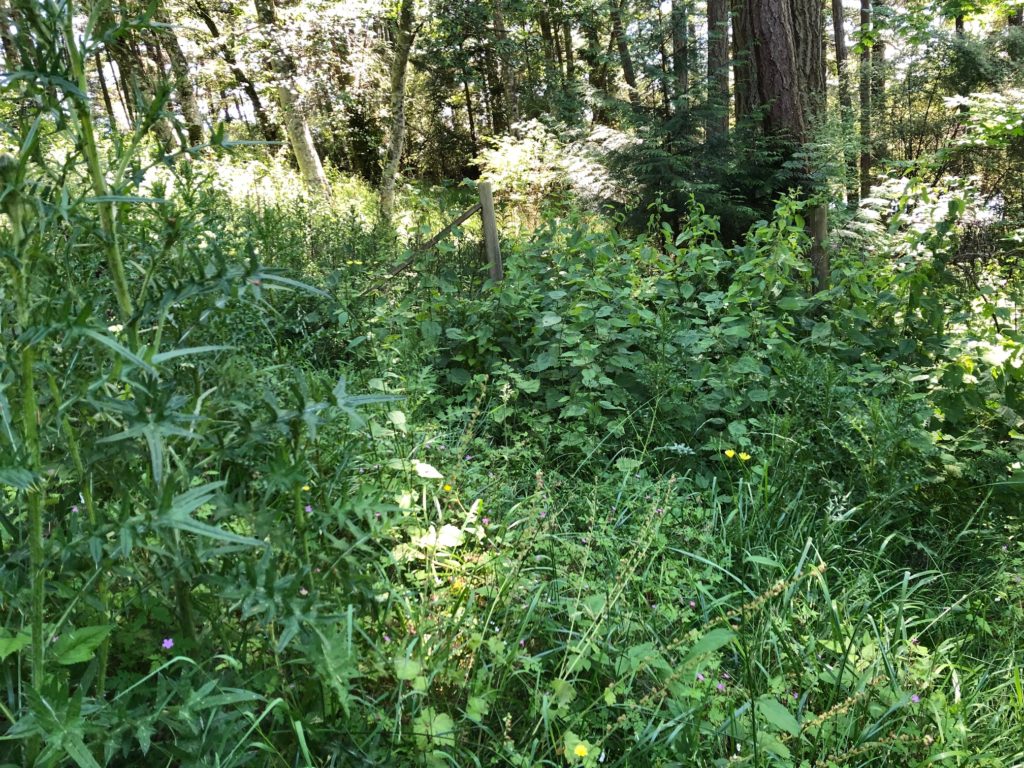
We have a deer fence on our property, which encloses the house, the front lawn and garden (and part of the pond), the back lawn and garden, and what I like to call the “back forty.”
The back forty is a sort of no-man’s land, worst of both worlds: unplanted, un-landscaped, yet also un-nibbled by deer; a protected area of…well, thistles and nettles and vines, as it happens. Never intended to be part of the garden, as far as we can tell. It’s kind of steep, and the soil is kind of sandy, and it’s where the septic tank vents are, and (until we had a tree cut down) it was pretty shady. In short, just an ugly mess.
It wasn’t so bad when we first moved here, four years ago. Clearly, the previous owners had at least kept it mowed. There’s a wonderful hammock at the edge of the field, strung between a couple of tall cedar trees. Nice weeds grow too, here and there: bracken ferns and foxglove and wild strawberries and a local geranium.
But, four years of complete neglect will really take its toll. So a few weeks ago, I decided to do something about it.
It started simply, innocently. As these things do. I had mowed the back lawn and was trimming around the borders, in the process pulling up some of what I call pernicious vines (I don’t know what they’re called for real; they grow every-the-hell-where here, all over the island), when my husband Mark said, “Hey, if you get a chance, can you prune a bit down there?” And he pointed to the very edge of the back forty, where some wild catmint had flowered last year, gone to seed, and then turned brown and ugly over the winter.
“Sure thing,” I said, and proceeded to do so.
Well, there was more pernicious vine down there. It’s so satisfying to pull up, oh let me tell you. You just give a gentle pull and often you can get the roots; it’s one of those jerks that reroots every few feet, so if you get going at the right angle and the soil is moist enough, you can drag up yards and yards of the stuff.
(And if you’re wearing gloves, it doesn’t even stab you with its nasty little thorns, ahem.)
This isn’t blackberry, by the way, though we have that too. This is just…pernicious vines.
Anyway. I pruned, I pulled, I kept glancing out at the depths of hell and horror right before me, thinking, Someday we really need to get to that…
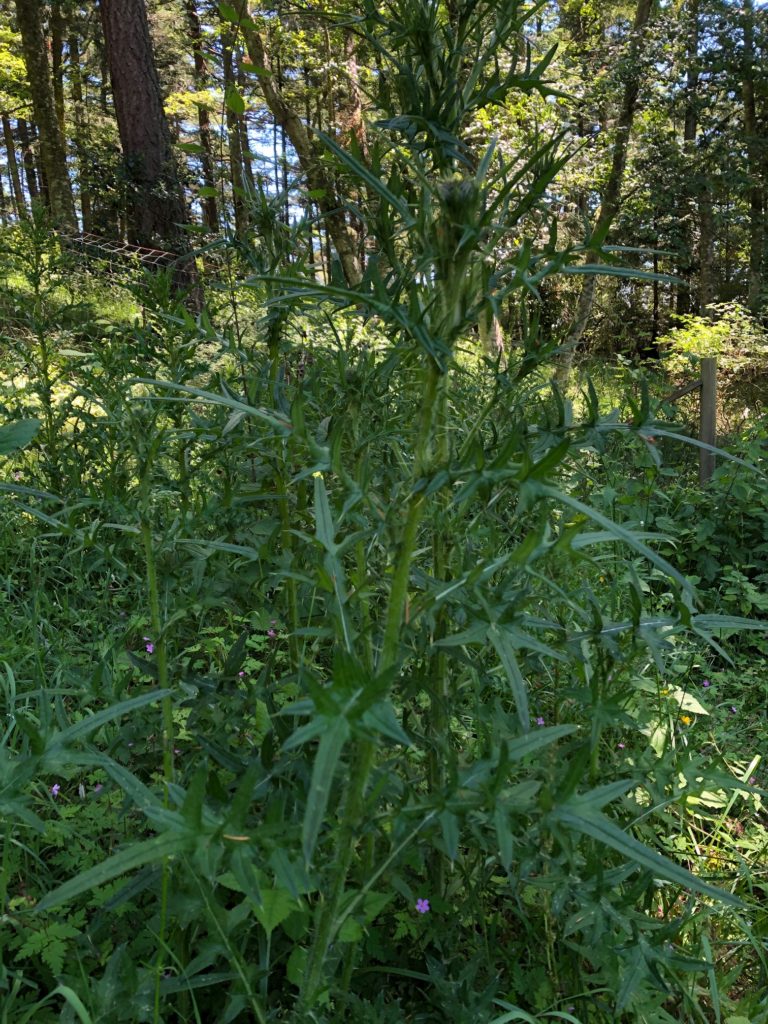
But, ugh, not just then. Those damn thistles, some of them were taller than me.
Well a funny thing happened. I got so caught up in pulling the pernicious vines that I sort of…cleared an area. By (gloved) hand.
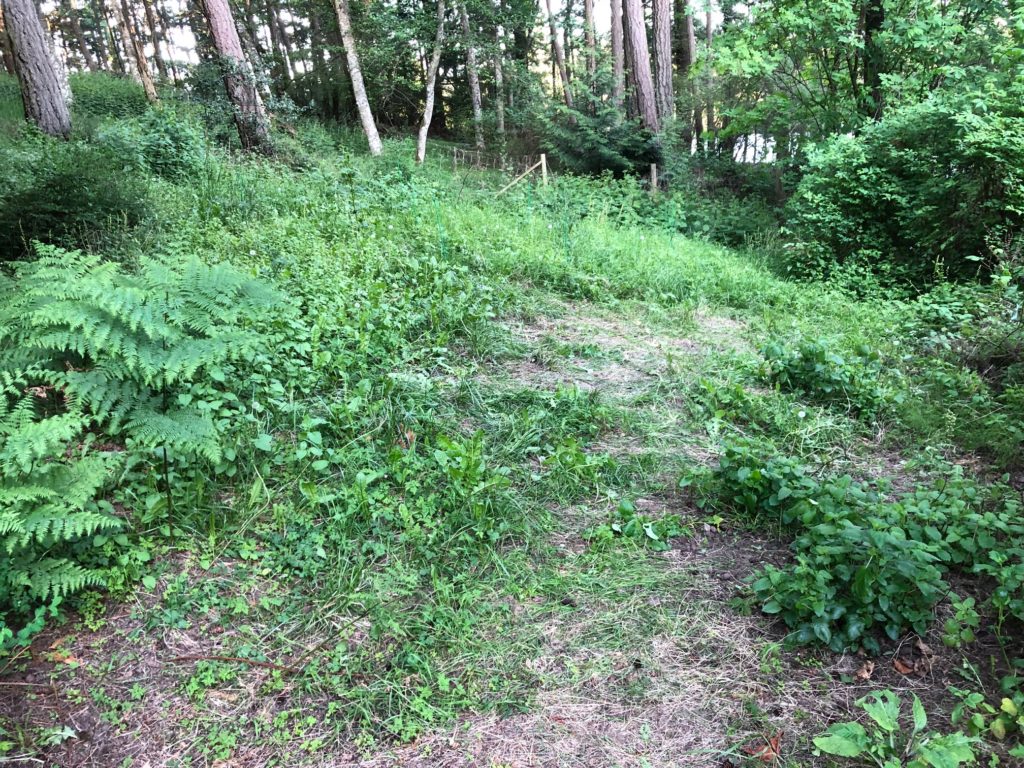
I know it doesn’t look like much…but it, well, emboldened me. And it gave me a sense of what the back forty could look like, what it probably did look like when we first moved here.
I liked it. And I loved pulling those pernicious vines, stacking them high on the yard waste pile. So I kept on with it.
It took a while, days and days of weeding, to get over to the thistles. I was afraid of them; I was even more afraid of the stinging nettles. Up till then, I’d been doing this on lovely warm days, wearing a tank top and sandals and light summer pants.
For the pricklier, sting-ier bastards, I would need to suit up.
So I waited for a colder day, and put on jeans, wool socks, real shoes, and a long-sleeved sweatshirt with thumb hooks that tucked inside the gloves.
When I brought my first thistle down, I felt like I’d slain a monster.
When I pulled out the first row of nettles, I felt as if I could slay any monster. I marched up from the back forty to the yard waste pile, prickly nasty beasties held high overhead, crowing my victory.
I dug up and pulled out loads of blackberry back there too. I unearthed giant fallen tree branches, hidden in the underbrush; threw the ones I could lift over the fence, piled the ones I couldn’t to be dealt with later.
And I reclaimed the lovely hammock, frequently resting after my day’s labors, peering out over my new, ever-expanding domain.
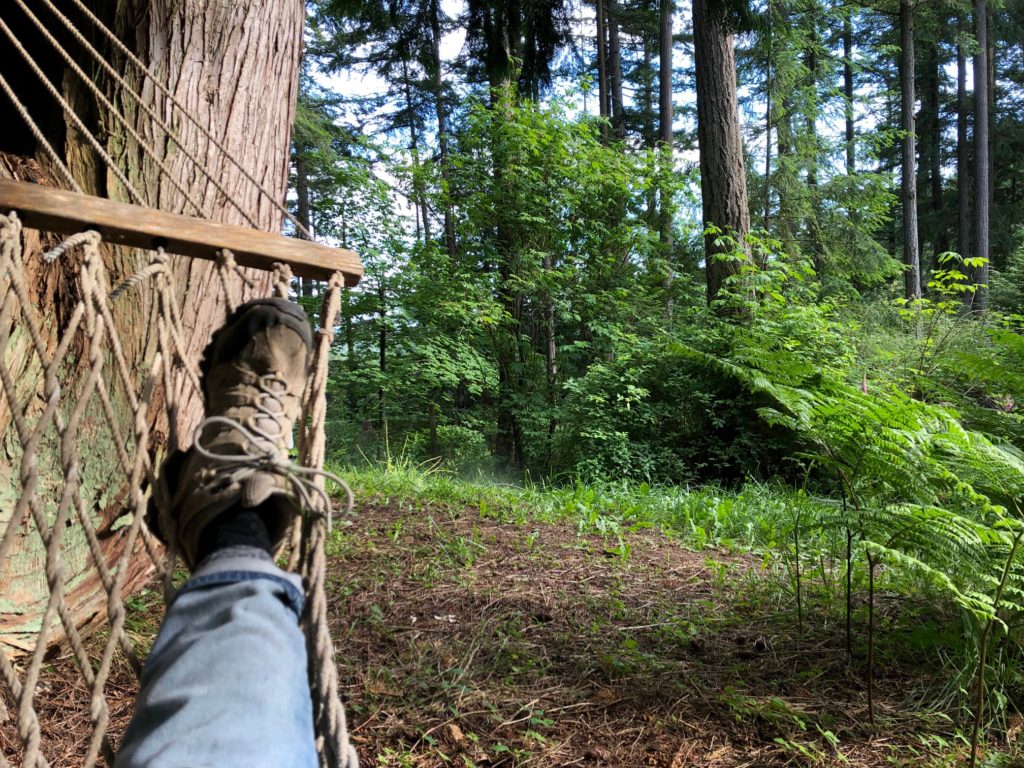
Every day I weeded, I’d make Mark hike down there with me so he could praise my efforts. Eventually, he looked around and said, “What about if we plant some Shasta daisies down here?”
Great idea!
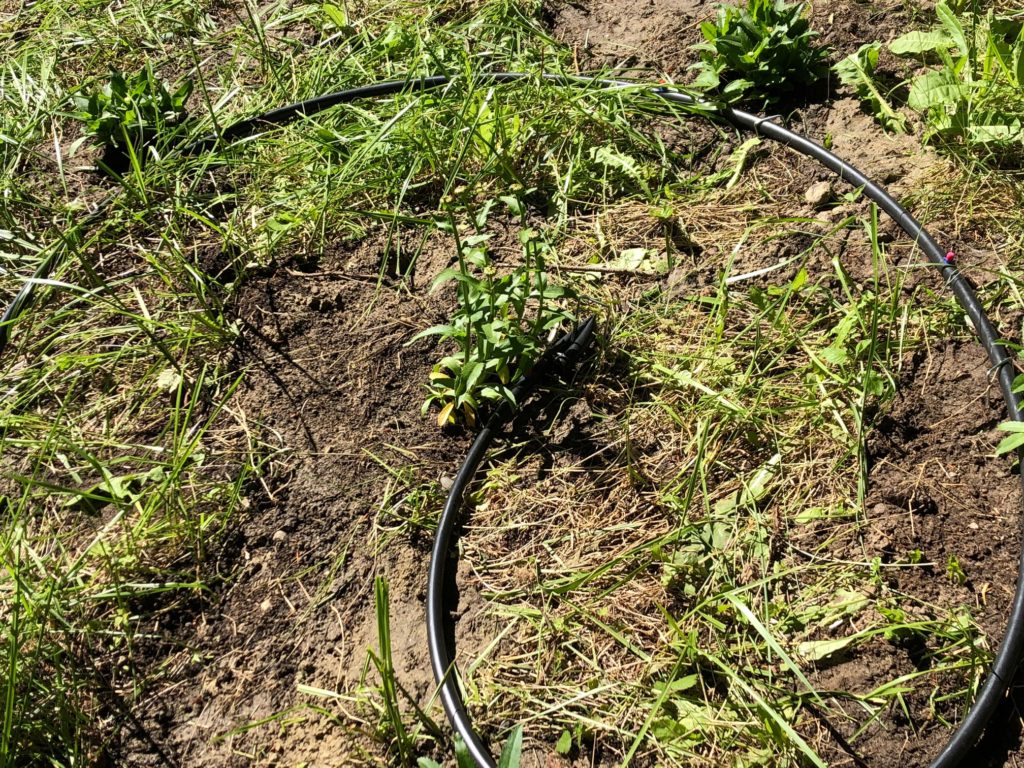
He even added them to the watering system, so maybe they’ll actually survive.
When I was nearly done, when I was clearing the far fence of the final, terrible stand of nettles (right-hand-middle side of the photo at the top of this post), I unburied a portion of the fence that was a little lower than the rest, with a bit of rolled-up fencing leaning against it, as though someone had been planning to shore up that section, but never got to it.
A bird had built a nest in that rolled-up fencing. I peered in, and saw two tiny eggs…and a newborn baby bird.
I called Mark over to see. The baby bird was alive, and we quickly realized the bird sounds we were hearing in the nearby trees (there’s a lot of birdsong around here these days) was likely the mother bird, very distressed.
So we slowly backed away, and I decided the final nettles could wait a bit to be dealt with. Mark retrieved last year’s Christmas tree from the yard waste pile and leaned it against the fence, to restore some of the privacy for Mama Bird and her young ones. Fortunately, Mama flew right back in there as soon as we left them be. Here’s hoping we didn’t mess things up for them too badly.
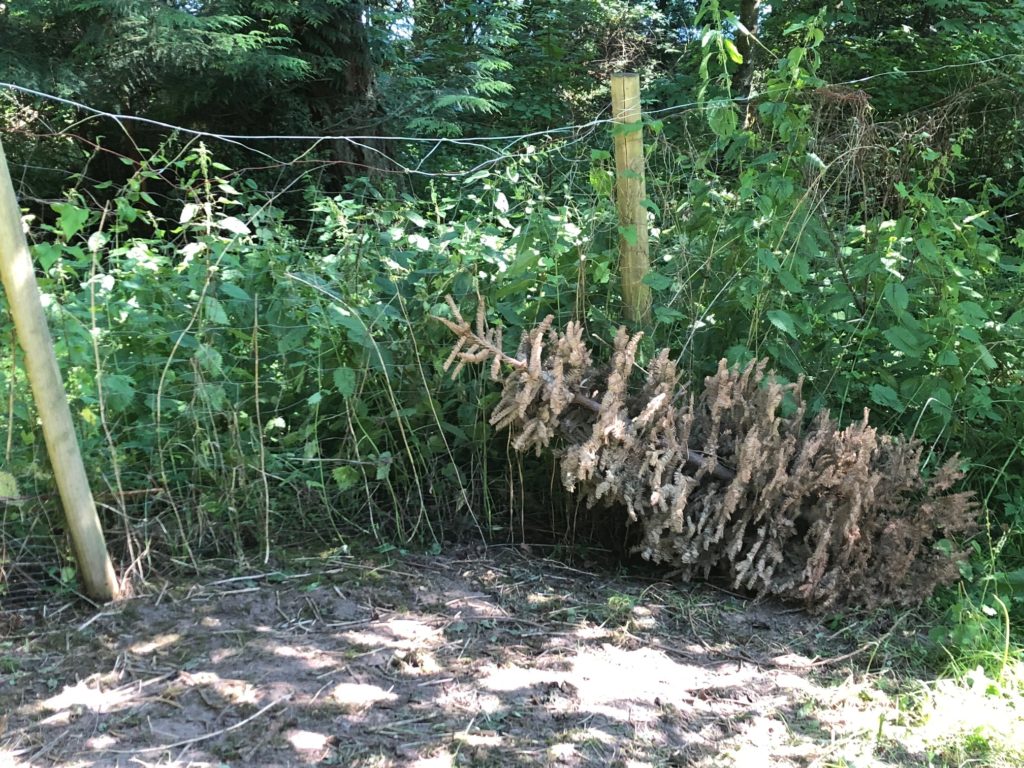
Mark also shored up the sagging fence a bit, with some wire, so the local deer don’t see the cleared spot and think, Hey, what’s in there? Is that for me?
Anyway, despite being not-quite-finished here, I’m absurdly pleased with my efforts. I hope the Shasta daisies take; if they do, we’ll look into other things that don’t need a lot of tending, that don’t need rich soil. And in any event, I plan to keep the area mowed, and keep pulling up pernicious vines when they reassert themselves (because they will, oh yes they will).
You guys, I think I’ve just expanded our garden.
Pingback: Island Life: Thistles and Nettles and Vines, Oh My |
Wow, that is a lot of hard work, but a very good result! I’m wishing you much enjoyment of your expanded garden.
Do leave the nettles outside the fence, even though that means you’ll have to keep guarding your borders against them encroaching, as they are a necessary caterpillar-foodplant for several kinds of butterflies.
There are quite a few early spring flowering bulbs and plants that like growing underneath trees. They’ll often disappear underground once the trees are in full leaf, but give a lovely early start to the garden right after the snow is gone. Cyclamen coum (slow to spread, but lovely as a rare, small and very early accent, near a path or someplace where you can see it), Anemone blanda (a good combination with snowdrops, as it too prefers undisturbed soil and isn’t very dense), Allium ursinum (Bear garlic, smells of garlic, the woods near my sister are carpeted with it in spring and it can be a bit strong…), Hyacinthoides non-scripta & some of the other wild hyacinths like hispaniola are also good at spreading out (wild bluebells, smell heavenly for a few weeks in spring), Scilla siberica & other Scillas, Pushkinia, snowdrops and other such small bulbs can be planted and left in the ground to slowly spread out. Snowdrops really need their soil to be left undisturbed if you want them to spread out and carpet the floor of your woodlot, and it takes a decade or two to get a real good show.
Around here, Lesser Celandine (Ficaria verna) is considered edible in salads and a spring treat for the rabbits and guinea-pigs, it carpets half my garden in 10-12 inches high mounds of fresh green leaves and lots of yellow star flowers each March, then disappears by the time the other plants start growing out in April – but I read that it’s considered an invasive species in North America, and it spreads really fast, so don’t plant that!
Lots of kinds of geraniums will grow and flower in shade, to give some colour in summer; and low blueberry bushes (Vaccinium myrtillus) thrive as undergrowth in some of the Swiss forests (steep, shady, poor soil) where we used to walk during our summer holidays, producing very small but very tasty berries for blueberry pies later in the summer.
Maybe plant a honeysuckle (Lonicera) to scramble up a tree? They like their roots to be in permanent shade but will grow and climb up towards the light. I love the scent of it after rain, or in the evening. They do grow into a wild tangle up in the tree, but if you put one in the wilder back forty where it’s less visible but you can get the scent wafting by your hammoc it might do well.
Great info, thank you thank you!! 🙂
Consider plants that are endemic to the area. The birds and bees will bless you for it. Also, being local, they will require less maintenance which is always a very, very good thing.